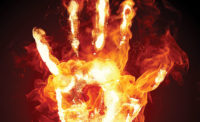Protecting utility linemen from arc flash events
“Getting a hard job done right”

About 30 to 50 workers in every 100,000 are killed doing utility line work every year, and many more suffer non-fatal but life-changing loss of limbs from electrical burns and trauma. With a fatality rate more than twice that of police officers and fire fighters, utility line work is one of the ten most dangerous jobs in the U.S.
Arc flash events are a clear and present danger. Exposure to their intense heat for one-tenth of a second can cause a second-degree burn. Temperatures of 205⁰ F will cause a third-degree burn, leading to complete skin loss in the exposed areas.
A pressure wave blast from a high-amperage arc can travel several feet with a force of up to 1,000 pounds. That’s enough to toss a victim backwards, causing injury from falls and impact; it can also cause hearing loss.
About 75 percent of arc flash incidents occur when a worker is near the equipment. The Fire Protection Research Foundation reported two-thirds of workers involved in arc flash incidents were injured when companies failed to conduct an arc flash analysis for selecting PPE. A separate study found 40 percent of electrical incidents involved 250 volts or less.
NFPA 70E details areas of protective clothing sometimes neglected by linemen. Outerwear – jackets and rainwear – thrown over arc-rated clothing should also be arc-rated. Underwear comprised of meltable fibers such as polyester, nylon and spandex should not be worn next to the skin. Sleeves should be fastened at the wrists and shirts tucked into pants. The legs of pants and sleeves of shirts should come completely down to the ankle and wrist, forming total coverage when combined with voltage-rated gloves, protective footwear, safety glasses, hearing protection and hardhats.
A bullet-proof mindset
Any lineman who has climbed a pole or opened a switch knows about safety. But OSHA-mandated arc-rated FR clothing sometimes is not worn because many linemen have a bullet-proof “it can’t happen to me” mindset. Consider the average age of a utility fieldworker is 50. As one veteran told another journeyman lineman, “Son, I’ve been doing this since before you were born. I know what to do and when to do it.”
Case study
The need for utilities to provide a full ensemble of arc-rated FR PPE, in addition to mandatory OSHA requirements, is illustrated by this case study. In February 2013, a three-man crew started maintenance work on a switch cabinet. The cabinet was not de-energized because the work plan did not call for it. After finishing the job, the crew decided to check other cabinets. On the last box checked the crew experienced a primary 7,200-volt phase-to-ground fault. Due to the arc-in-a-box effect, the ensuing explosion torched the lineman standing in front of the switch cabinet. He was wearing all the PPE required at the time. A hard hat protected his hair. Safety glasses protected his eyes. Gloves protected his hands. His arc-rated fleece sweatshirt and FR fabric pants performed well and took the brunt of the arc flash. Cotton undergarments were covered by the outer layer of arc-rated clothing.
Only his face was unprotected, which received first- and second-degree burns. The arc flash worked around the back and front of his body, and if he had not been wearing his entire arc-rated ensemble, he would have sustained severe burns. He was transported to a local hospital, treated, released, and subsequently missed one week of work. The utility company’s joint safety committee conducted an investigation. One recommendation: employees must wear arc-rated face shields rated at a minimum of 12 cal/cm2. The investigation concluded that when arc-rated PPE is properly used and worn, it can help prevent or limit the extent of injury.
A matter of life and death
That’s the aim of OSHA’s updated 1926 Subpart V (Construction) and 1910.269 (General Industry) standards revising safety standards for performing electrical power generation, transmission and distribution work. The final rule became effective July 10, 2014. Requirements for fall protection, minimum approach distance, and arc protection were phased in between October 2014 and April 2015. Arc protection standards required compliance beginning January 1, 2015. Employers must estimate the incident heat energy of any potential electrical-arc hazard exposures to employees and implement programs and systems based on the risk assessment. NFPA standard 70E, 2015 edition, requires specific levels of PPE for various types and ratings of electrical equipment.
The updated OSHA standards were a major safety story for utilities. OSHA estimates the total cost for FR clothing in its final rule at an annualized cost of about $452.88 per employee. The high-risk utility industry has upped its game accordingly. As one utility company executive said, wearing specially made arc flash protective clothing is a matter of life and death, and ensures everyone a safe work environment to get a hard job done right.
78 days away from workJust-released data from the Bureau of Labor Statistics shows that electrocution-related accidents take a high toll on U.S. workers. According to the statistics, local government employees who work on power lines averaged 78 days away from their jobs in 2014; this is almost double the next-highest total (40 days for construction laborers). Every year, hundreds of Americans are killed — and thousands injured — due to electrical hazards. Among workplace causes of death, electrocution ranks sixth. For survivors and loved ones affected by electrocution-related accidents, life will never be the same. Who is affected by electrocution accidents? Workers in two industries — construction and installation/maintenance/repair — suffered the highest number of electrocution-related fatalities on the job between 2003 and 2007. Among fatal workplace incidents in private businesses in 2014, more than one in five occurred in the construction industry, according to the most recent OSHA statistics. Electrocution ranks second on the list of top causes of death for workers at construction sites, after falls. These “Fatal Four” — which also include being struck by an object or becoming caught between objects — accounted for nearly 60 percent of the 74 construction worker deaths last year. Labor trade contractors at high risk of electrocution-related accidents include roofers, tree-trimmers, sewer and pipeline personnel, and painters. Heavy equipment among worst culprits More than half of all occupational electrocutions occur in the construction industry, and heavy equipment often plays a role. Among incidents of contact with overhead power, heavy equipment accounted for half, including: cranes, 56.5 percent; drilling rigs, 7.7 percent; dump trucks, 6.7 percent; and bucket trucks, 6.7 percent. |
Sources:
https://www.osha.gov/oshstats/commonstats.html
http://www.bls.gov/news.release/osh2.toc.htm
http://www.bls.gov/news.release/osh2.t04.htm
http://www.electrocuted.com/safety/statistics/
Looking for a reprint of this article?
From high-res PDFs to custom plaques, order your copy today!








